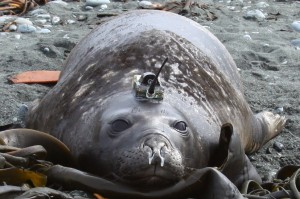
Elephant seals have again been key to the ability of researchers to establish the source of an important secondary contribution to East Antarctica’s Cape Darnley bottom water. Antarctic bottom water is formed when cold, salty and dense water sinks and flows away from the continent in enormous volumes. It is considered an important aspect to understanding changes in global ocean circulation patterns, that in turn can lead to a changing climate throughout the world.
In 2011 scientists discovered a fourth source of this water mass off Cape Darnley. Elephant seals assisting with this research were tagged with oceanographic sensors as part of Australia’s Integrated Marine Observing System. When the animals surface their sensors relay information back to land via satellite, and the near real-time data is made available via the Global Telecommunication System of the World Meteorological Organisation for immediate use. The oceanographic data collected by the seals is also used for ecological research into the animals’ behaviour, and aids in conservation.
The latest research by the international team led by Guy Williams from the Institute for Marine and Antarctic Studies, and the Antarctic Climate and Ecosystems CRC, was also aided by the seals, and shows Prydz Bay makes an important secondary contribution to Cape Darnley bottom water, despite it being less salty and dense due to the influence of fresh water by nearby ice shelves.
The results highlight the ‘susceptibility of Antarctic bottom water to increased freshwater input from the enhanced melting of ice shelves, and ultimately the potential collapse of Antarctic bottom water formation in a warming climate’.
“The study would have been virtually impossible without help from the seals, who can gather oceanographic data from areas that tend to be very difficult to access in research ships. They have the advantage of continuing to forage and record ocean properties through the winter, exploiting small cracks and leads in the sea ice cover to breathe and allow for data transmission,” Williams said.
He said the seals were doing an ‘outstanding’ job in advancing the understanding of the global ocean system.
The seal-tagging component of IMOS is made possible with logistical support and funding from the Australian Antarctic Program.
ANNE LAYTON-BENNETT
‘The suppression of Antarctic bottom water formation by melting ice shelves in Prydz Bay’ is available here.

